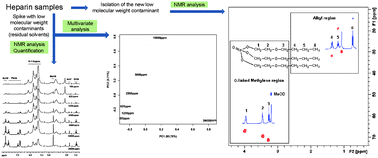A robust method to quantify low molecular weight contaminants in heparin: detection of tris(2-n-butoxyethyl) phosphate†
Abstract
Recently, oversulfated

* Corresponding authors
a Departamento de Bioquímica e Biologia Molecular, Universidade Federal do Paraná, Curitiba, Brazil
b Istituto di Richerche Chimiche e Biochimiche “G. Ronzoni”, via Giuseppe Colombo 81, Milan, Italy
c Departamento de Bioquímica e Biologia Molecular, Universidade Federal de São Paulo, Brazil
d School of Biological Sciences, University of Liverpool, Liverpool, UK
Recently, oversulfated

 Please wait while we load your content...
Something went wrong. Try again?
Please wait while we load your content...
Something went wrong. Try again?
G. L. Sassaki, D. S. Riter, A. P. Santana Filho, M. Guerrini, M. A. Lima, C. Cosentino, L. M. Souza, T. R. Cipriani, T. R. Rudd, H. B. Nader, E. A. Yates, P. A. J. Gorin, G. Torri and M. Iacomini, Analyst, 2011, 136, 2330 DOI: 10.1039/C0AN01010C
To request permission to reproduce material from this article, please go to the Copyright Clearance Center request page.
If you are an author contributing to an RSC publication, you do not need to request permission provided correct acknowledgement is given.
If you are the author of this article, you do not need to request permission to reproduce figures and diagrams provided correct acknowledgement is given. If you want to reproduce the whole article in a third-party publication (excluding your thesis/dissertation for which permission is not required) please go to the Copyright Clearance Center request page.
Read more about how to correctly acknowledge RSC content.
 Fetching data from CrossRef.
Fetching data from CrossRef.
This may take some time to load.
Loading related content
